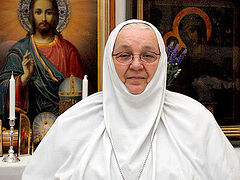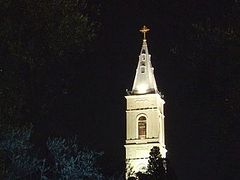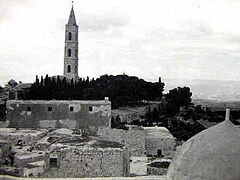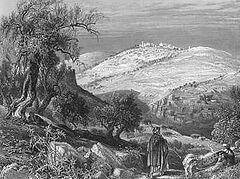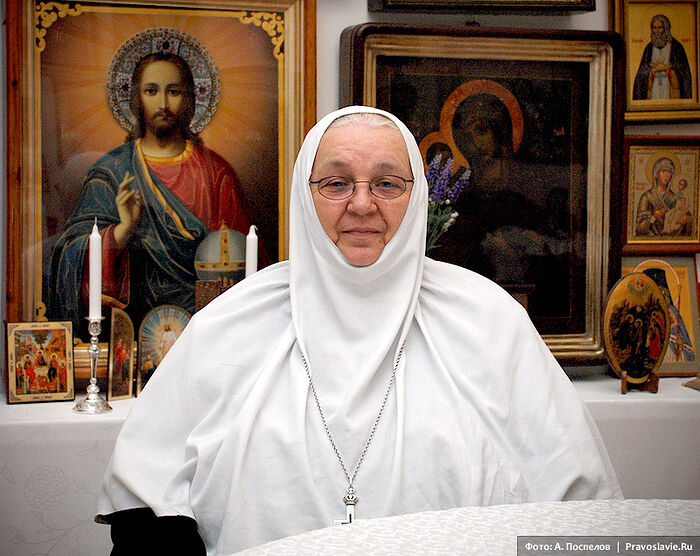 Abbess Moisseia(Bubnova). Photo by A. Pospelov / Pravoslavie.ru
Abbess Moisseia(Bubnova). Photo by A. Pospelov / Pravoslavie.ru
On the night of March 8, 2021, After Meatfare Sunday and at the beginning of Maslenitsa Week, retired Abbess Moisseia (Bubnova) of the ROCOR Holy Ascension Convent on the Mount of Olives, peacefully fell asleep in the Lord in a Jerusalem hospital at the age of seventy-seven, having suffered from complications due to the coronavirus.
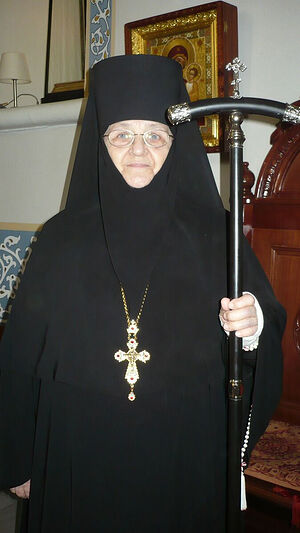 Abbess Moissea. Bright Week of 2016 She was one of the most distinguished and famous abbesses of the Russian Orthodox Church in the late twentieth and the early twenty-first centuries and a prominent high-ranking figure in the Holy Land.
Abbess Moissea. Bright Week of 2016 She was one of the most distinguished and famous abbesses of the Russian Orthodox Church in the late twentieth and the early twenty-first centuries and a prominent high-ranking figure in the Holy Land.
In 2017, the ROCOR hierarchy awarded her the honor of wearing two jeweled crosses. In Jerusalem, only the current ninety-year-old Honorary Abbess of Gorny Convent, Mother Georgia (Shchukina), has a similar award. In the Russian Orthodox Church, not the least in Russia, it is an extremely rare award that only a few prominent pious Orthodox may receive for many years of diligent service of the Orthodox Church of Christ.
For nearly two decades—between 1997 and 2017—Mother Moisseia ruled one of the most renowned convents in the world—the Russian Convent of the Ascension of the Lord on the Mt. of Olives in Jerusalem. Her abbacy was marked by the status, the material and technical transformation and renewal of this great monastic community. I was privileged to know Abbess Moisseia from Bright Week of 2010 when she first blessed me to stay at the holy Russian convent for some time. From that day on my regular visits to this holy place began.
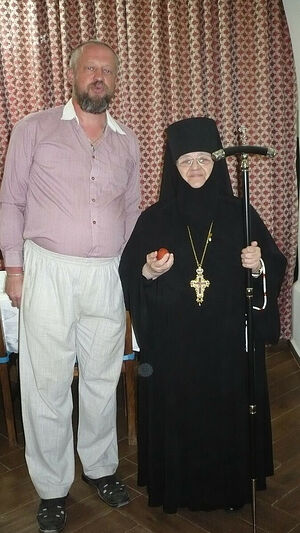 Abbess Moisseia with the author, V. Nikolaev, during the Paschal meal of 2016 The future Abbess Moisseia (secular name: Galina Dmitrievna Bubnova) was born in 1943 in Germany to a family of Russian emigres. Before entering a convent as a novice, Galina Bubnova and her family had gone through many trials. Her father, Dmitry Konstantinovich, a White Army officer, had to flee from Russia with Yudenich.1 Soon Anna Fyodorova, Galina’s mother, lost her motherland forever as well. As a student of Oxford University she was cut off from her roots when the Soviet troops entered Estonia, where her family had lived. The first meeting of two forced emigrants, which took place under tragic circumstances, turned out to be the most romantic.
Abbess Moisseia with the author, V. Nikolaev, during the Paschal meal of 2016 The future Abbess Moisseia (secular name: Galina Dmitrievna Bubnova) was born in 1943 in Germany to a family of Russian emigres. Before entering a convent as a novice, Galina Bubnova and her family had gone through many trials. Her father, Dmitry Konstantinovich, a White Army officer, had to flee from Russia with Yudenich.1 Soon Anna Fyodorova, Galina’s mother, lost her motherland forever as well. As a student of Oxford University she was cut off from her roots when the Soviet troops entered Estonia, where her family had lived. The first meeting of two forced emigrants, which took place under tragic circumstances, turned out to be the most romantic.
“Imagine the beginning of the Second World War. My mother was in the deepest mourning (her first husband had died of tuberculosis two months earlier). She was walking down the street, pushing a stroller with her newborn son in front of her and weeping,” Mother Moisseia recalled. “And suddenly she ran right into my future father. And, barely looking at my mom, he fell helplessly in love with her.”
The Lord created a new family, in which two girls were born, one of whom was destined to become a very famous and authoritative abbess of ROCOR.
Three days before the end of WWII the Bubnovs moved to Belgium.
From her childhood and youth the future abbess was in constant contact with holy Archbishop John (Maximovitch) and from the age of nine sang and read in the choir. Contact with such a great saint left a special imprint on her life. Subsequently, she repeatedly said that from her early childhood the Lord Himself and the Queen of Heaven had sent her one of the main pillars of the Russian Orthodox Diaspora, after contact with whom there was no other way than to serve the Church.
In her early youth, Galina Bubnova was a guide in the Vityazi (“Knights”) Youth Association in Belgium. She obtained a higher education, majoring in commerce, and worked at the Solvay chemical company for twelve years. In addition to Russian, she was fluent in three languages: English, French and German. But the soul of young Galina, a disciple of St. John of Shanghai, demanded service only in the Orthodox Church of Christ. And so she decided to join the ROCOR Convent of St. Mary Magdalene near the Garden of Gethsemane in the holy city of Jerusalem.
Before that, in 1970, Galina Bubnova had visited the USSR to see her aunt who lived in the town of Pechory in the Pskov region in rather poor, one might say pauper-like, conditions. When the Soviet authorities found out that a foreigner from Belgium was going to Pechory, they provided running water and electricity for Galina’s relative. According to Mother Moissea, the KGB men tried to persuade her to cooperate with their agents, but she refused. So until 1992, she was banned from visiting Russia.
From 1975 Novice Galina Bubnova lived in the ROCOR convent of St. Mary Magdalene where she performed obediences as the convent’s clerk, sang and read in the choir, did the bookkeeping, and was also a guide. Before that she had asked God for a sign: whether or not she should serve Him as a nun. And the Lord revealed His will to her restless young soul at His tomb in the Church of the Resurrection.
In 1977, Galina was tonsured a riassaphore nun with the name Nonna. Just fifteen years later, in 1992, was she tonsured a stavrophore nun with the name Moisseia in honor of St. Moses the Black. As she used to say, to receive the monastic tonsure at that time was very difficult.
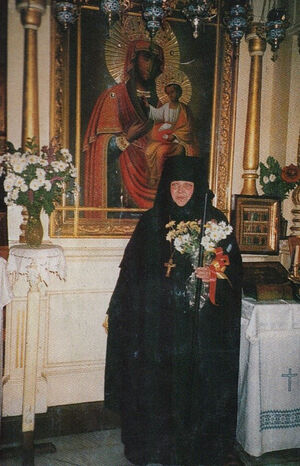 Mother Moisseiaon the day of her elevation to the rank of abbess. The Mt. of Olives, 1997 A remarkable couple—Mstislav Rostropovich and Galina Vishnevskaya—attended her monastic tonsure. During the ceremony Vishnevskaya cried bitterly: she was sorry that the young woman, now clothed in black robes, would never marry and find happiness in the family life…
Mother Moisseiaon the day of her elevation to the rank of abbess. The Mt. of Olives, 1997 A remarkable couple—Mstislav Rostropovich and Galina Vishnevskaya—attended her monastic tonsure. During the ceremony Vishnevskaya cried bitterly: she was sorry that the young woman, now clothed in black robes, would never marry and find happiness in the family life…
In 1997, after the sad events at the Mount of Olives Convent, when Abbess Juliania was removed from her post after denying His Holiness Patriarch Alexei II admission to the convent, in the autumn of that year by decree of the ROCOR Holy Synod Nun Moisseia (Bubnova) was appointed its next mother-superior. By tradition Patriarch Diodoros I of Jerusalem personally gave Mother Moisseia his blessing to become an abbess on the Mount of Olives. Archbishop Hilarion (Kapral) of Australia (the future First Hierarch of ROCOR) elevated Mother Moisseia to the rank of abbess and presented her with the abbess’ staff. From that moment on the heavy yet saving path for Abbess Moisseia began.
The convent was extremely poor. All the water pipes, equipped under Abbess Tamara, had become out-of-date and needed repair. The situation was complicated by the fact that the convent was surrounded on all sides by Muslims who wanted to take over part of its land. In 2000, on the night of the winter feast of the St. Nicholas (December 19), Mother Moisseia was attacked right in the abbess’ building.
Demanding all the convent’s money from her, the bandits shot at the abbess, and only St. Nicholas’ invisible intercession saved her from the imminent death: As the bandits were raging the other sisters returned from the night service at the Holy Sepulcher and the gunmen fled. As Mother Moisseia used to say: “My sisters and I are at the front every day.”
Despite the enormous everyday difficulties and temptations of the monastic life, thanks to the protection of our Lord and Savior Jesus Christ, the Theotokos and the greatest saints of Jerusalem, through the prayers of the abbess herself, her sisters, the clergy and pilgrims, the holy convent of the Mt. of Olives gradually began to establish itself on solid foundations, became better off and had beautiful flower beds and gardens.
Large groups of pilgrims from all over the globe began to flock to the convent, which dramatically raised its religious and Orthodox status as one of the main holy places of Jerusalem and greatly strengthened its financial position.
The convent was well equipped and transformed; its churches, water supply, plumbing, electricity, heating, roads and paths, the sisters’ building and the hostel for pilgrims, internal and external walls and the fortifications, the refectory, workshops, gardens, flower beds, front gardens and the cemetery were repaired. The “Candle of Jerusalem”—the bell-tower of the Mt. of Olives, one of the main symbols of Jerusalem and the whole of Palestine—was renovated and began to “shine”.
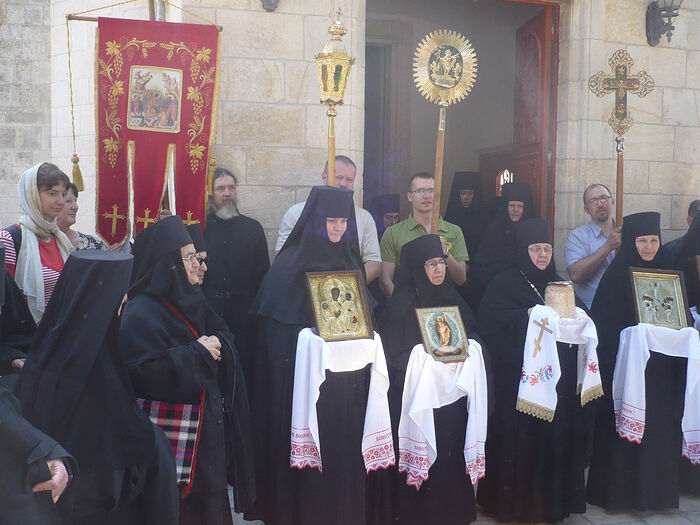 Bright week of 2010. Cross procession around the Ascension Cathedral. Abbess Moisseiais the second from the right, and Mother (now abbess) Barbara is the first from the right.
Bright week of 2010. Cross procession around the Ascension Cathedral. Abbess Moisseiais the second from the right, and Mother (now abbess) Barbara is the first from the right.
Nun Barbara (Novikova) has played an outstanding role in the work of the material and technical transformation of the convent. In 2002, with the blessing of Mother Moissea, Nun Barbara joined the convent after her daughter Maria. Mother Barbara, who has been the new abbess since 2017, together with other sisters, workers and pilgrims has carried out incredible labors for the benefit of the convent.
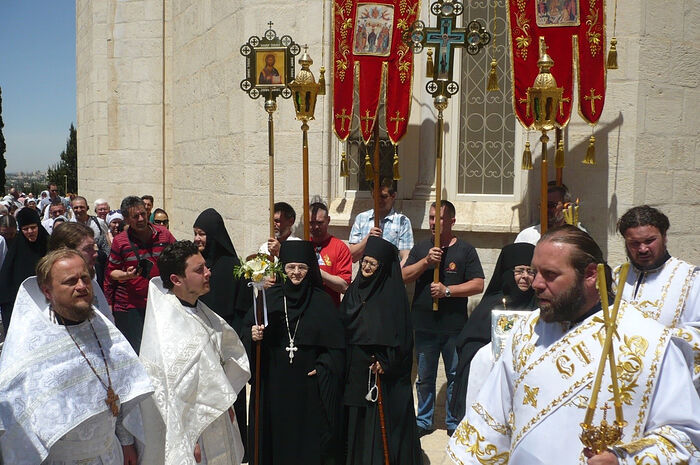 The Ascension Day of 2017. Cross procession. Mother Moisseiawith her staff and Mother Christina (both reposed in 2021) are in the center.
The Ascension Day of 2017. Cross procession. Mother Moisseiawith her staff and Mother Christina (both reposed in 2021) are in the center.
Mother Moisseia happily received the news of the reunification of the Russian Orthodox Church Outside Russia with the Moscow Patriarchate in May 2007. She was convinced that by this great act, Russia and the Moscow Patriarchate were taking the dioceses, parishes, monasteries and the whole flock of ROCOR under their direct patronage and protection.
Abbess Moisseia was revered by the primates and representatives of the Local Orthodox Churches. The Lord ordained her to carry out her ministry under three First Hierarchs of ROCOR (Vitaly, Laurus and Hilarion), two Patriarchs of Moscow (Alexei II and Kirill) and three Patriarchs of Jerusalem (Diodoros, Irenaios and Theophilos III). Her services to the Church are highly appreciated by the ROCOR hierarchy. In 2017, the 200th anniversary of the birth of Archimandrite Antonin (Kapustin), the founder of Russian Palestine, and the twentieth anniversary of her appointment as abbess, it was decided to grant her the right to wear a second jeweled cross. In the Russian Church, only two living abbesses have been awarded this right: Abbess Georgia (Shchukina) of Gorny Convent and Abbess Sergia (Konkova) of the St. Seraphim-Diveyevo Convent.
After retiring in the summer of 2017, Mother Moisseia attended all the major monastic Church services. A special chair was installed for her at the Ascension Cathedral.
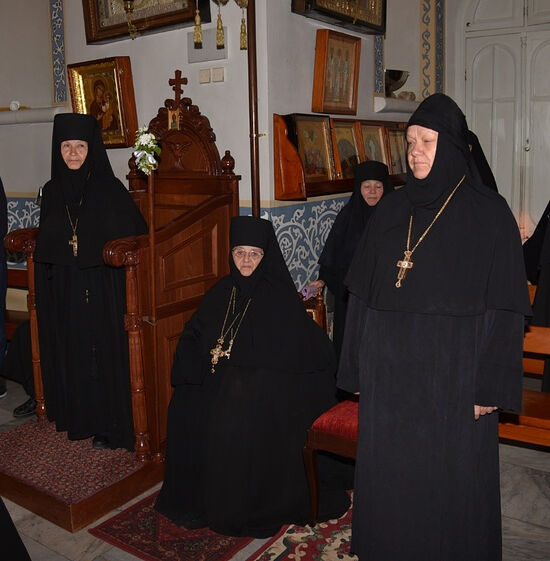 Abbess Barbara of the Ascension Convent, retired Abbess Moisseiaand Abbess Elizabeth of St. Mary Magdalene Convent in the Garden of Gethsemane. The Mount of Olives.
Abbess Barbara of the Ascension Convent, retired Abbess Moisseiaand Abbess Elizabeth of St. Mary Magdalene Convent in the Garden of Gethsemane. The Mount of Olives.
For the last seven or eight years of her life, Mother Moisseia was seriously ill, endured a lot of physical suffering, always remaining concentrated in prayer and never leaving the Mount of Olives. The current Abbess Barbara would often turn to her for advice; she revered her and aided her as the honorary abbess.
Mother Moisseia lived in renovated premises, where once the great Abbess Tamara (Romanova-Bagration-Mukhransky) had lived until her blessed repose in August 1979. Like Abbess Moissea, Mother Tamara had retired four years before her death and had been the convent’s honorary superior.
According to the will of the deceased abbess, she was buried on the territory of the Holy Ascension Convent on the Mt. of Olives.
Let us pay tribute to the newly-departed blessed Mother Moisseia (Bubnova) for her contribution to the work of preserving and increasing the glory of the convent. Let us honor her blessed memory with prayers for the repose of her soul!

